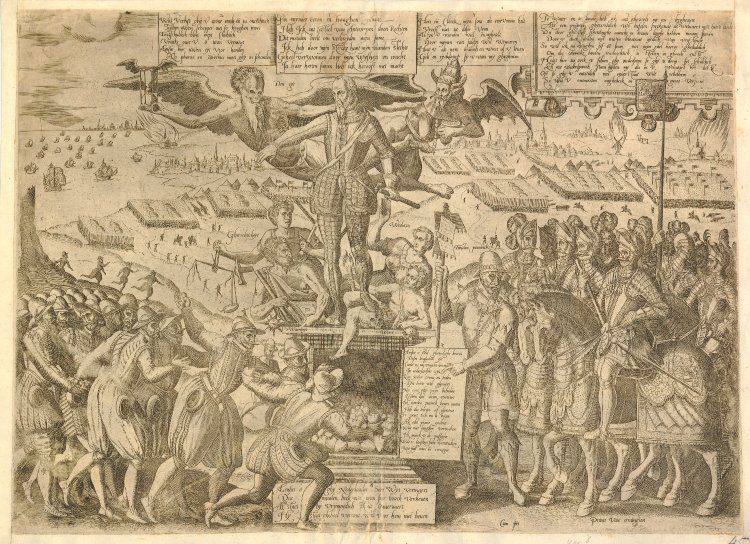File:Got mynder Eeren en hooghen Name.jpg
Got_mynder_Eeren_en_hooghen_Name.jpg (750 × 544 pixels, file size: 151 KB, MIME type: image/jpeg)
Captions
Captions
Summary[edit]
| Got mynder Eeren en hooghen Name (Broadside on the tyranny of the Duke of Alba)
( |
||||||||||||||||||||||||
|---|---|---|---|---|---|---|---|---|---|---|---|---|---|---|---|---|---|---|---|---|---|---|---|---|
| Title |
Got mynder Eeren en hooghen Name (Broadside on the tyranny of the Duke of Alba) |
|||||||||||||||||||||||
| Description |
Print published in Antwerp in 1571 by Volcxken Diericx. The print refers to the tyranny of the Duke of Alba in the Netherlands, and his institution of the Council of Troubles, which was nicknamed the Council of Blood. In 1572 the Gueux (Dutch freedom fighters) captured most of Holland and Zeeland, and the Prince of Orange and his brother Louis of Nassau invaded the Netherlands from Germany and France, respectively. However, Alba defeated the land invasions and recaptured part of Holland, where his troops committed terrible atrocities. In the end, he was unable to defeat the Gueux and he failed to recapture the remainder of Holland and Zeeland. The attribution of the publication to Volcxken Diericx, widow of Hieronymus Cock, is taken from Drugulin. |
|||||||||||||||||||||||
| Date |
1571 date QS:P571,+1571-00-00T00:00:00Z/9 |
|||||||||||||||||||||||
| Medium | engraving | |||||||||||||||||||||||
| Dimensions |
height: 35 cm (13.7 in); width: 48.5 cm (19 in) dimensions QS:P2048,35U174728 dimensions QS:P2049,48.5U174728 |
|||||||||||||||||||||||
| Collection |
institution QS:P195,Q6373 |
|||||||||||||||||||||||
| Source/Photographer | https://www.britishmuseum.org/research/collection_online/collection_object_details.aspx?objectId=1487270&partId=1&searchText=Volcxken+Diericx&page=1 | |||||||||||||||||||||||
| Permission (Reusing this file) |
|
|||||||||||||||||||||||
File history
Click on a date/time to view the file as it appeared at that time.
| Date/Time | Thumbnail | Dimensions | User | Comment | |
|---|---|---|---|---|---|
| current | 08:39, 20 September 2019 |  | 750 × 544 (151 KB) | Mari-massu (talk | contribs) | {{Artwork |artist= |title = {{title|''Got mynder Eeren en hooghen Name'' (Broadside on the tyranny of the Duke of Alba)}} |description = Print published in Antwerp in 1571 by Volcxken Diericx.<br/> A broadside on the end of the tyranny of the Duke of Alba in the Netherlands, forced by the troops led by William I of Orange; with an engraving showing in the centre a figure of the Duke of Alba standing on a plinth, next to him representational figures of Death, the Devil in guise o... |
You cannot overwrite this file.
File usage on Commons
The following page uses this file:

